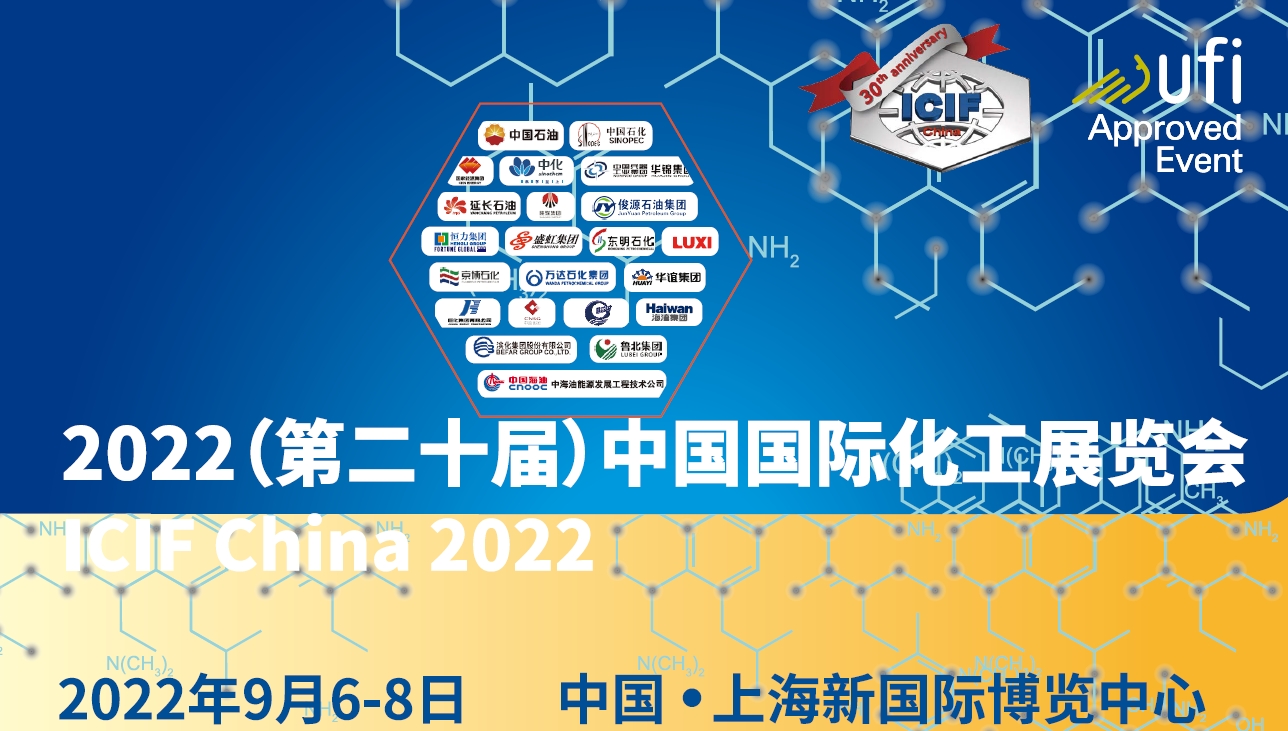Exhibition Name: 2022 (the 20th) ICIF China
Date: September 6-8, 2022
Venue: Shanghai New International Expo Center
Organizer: China Petroleum and Chemical Industry Federation
Organizer: Chemical Industry Branch of China Council for the promotion of international trade
Chemical Industry Trade Exchange Platform
About ICIF China
ICIF China, founded in 1992, is jointly organized by China Petroleum and Chemical Industry Federation, chemical industry branch of China Council for the promotion of international trade and China Chemical Information Center. It has been successfully held for 19 times. The exhibition focuses on the current petroleum and chemical industry products, materials and technical equipment, with the theme of “cohesion innovation – driving high-quality development”, runs through green, safety, environmental protection and intelligent solutions, and integrates exhibition, exchange and trade; As one of the important activities of the petrochemical Federation every year, it has been strongly supported and actively participated by member units and chemical enterprises for many years, highlighting the development and style of China’s petrochemical enterprises.
“ICIF China”, founded in 1992, is jointly organized by China Petroleum and Chemical Industry Federation, chemical industry branch of China Council for the promotion of international trade and China Chemical Information Center. It has been successfully held for 30 years.. With the theme of “cohesion and innovation – driving high-quality development”, the exhibition will build a one-stop trade and service platform of the whole industry chain for the petroleum, energy and chemical industry, and focus on the display of new products, new technologies and new ideas of the whole industry, from petrochemical industry, energy and chemical industry, basic chemical raw materials, fine and special chemicals, chemical technology and equipment, chemical packaging, storage and transportation Smart chemical – Smart manufacturing and other major suppliers gather together to provide a series of solutions for the petrochemical industry from raw materials and equipment to packaging, smart manufacturing and energy saving, escort petrochemical enterprises to improve output and quality, reduce costs, safe production, transformation and upgrading, and contribute to promoting industrial innovation and high-quality development!
Since 2018, China International Chemical Industry Exhibition, together with China International Rubber Technology Exhibition and China International adhesive and sealant exhibition, has jointly held an industry event “China Petrochemical Industry Week” at the same time. It provides a one-stop platform for product display, exchange and trade cooperation for petroleum and chemical enterprises, which aims to serve and promote enterprise technological progress and innovative business formats, help the high-quality development of the industry and lead the development direction of the industry.
China Petrochemical Industry week brings together more than 1600 exhibitors every year and exhibits more than 10000 products on site. In 2022, the total exhibition area is expected to exceed 100000 square meters and attract more than 60000 professional visitors.
Exhibit Scope:
Petrochemical and Energy Chemical Industry: shale gas and LPG such as crude oil, naphtha, condensate, light hydrocarbon, solvent oil, paraffin and petroleum product additives, asphalt, refining and chemical integration and bulk petrochemical products LNG, oilfield associated gas, coalbed methane, coke oven
Gas, coal chemical industry, hydrogen energy, energy storage, new energy, etc
Basic Chemical Raw Materials: inorganic and organic chemicals and raw materials, barium salts, magnesium salts, potassium salts, boron compounds and borates, bromine compounds, chromium salts, cyanide, oxygen compounds, phosphating compounds and phosphate, silicon compounds, silicate and other inorganic acids
Alkali salt, caustic soda, calcium carbide, activated carbon, carbon black, titanium dioxide, etc
New Chemical Materials: Organic fluorosilicone materials, engineering plastics, modified plastics, high-performance separation membrane materials, high-performance fibers, epoxy resins, high-performance resins, polyurethane materials, high-end polyolefin materials, aerospace, aviation special materials, military materials
Engineering and Special Environmental Materials, other new chemical materials, etc
Fine Chemicals: surfactants, catalysts, electronic chemicals, fine organic chemical raw materials and intermediates, ion exchange resins, agricultural chemicals, leather chemicals, dyes, poko and intermediates, daily chemicals and cleaners
Biological Chemicals, feed and food additives, water treatment chemicals, additives (plastic additives, special additives), purchased / customized synthetic / commissioned processing chemicals, flavors and fragrances, pharmaceutical raw materials and intermediates, fluorin.
Optical brightener, oilfield chemicals, additives, special chemicals, special chemicals, etc
Intelligent Chemical Industry – Intelligent Manufacturing Exhibition Area: key technical equipment of intelligent manufacturing, production process automation, intelligent packaging, logistics and storage, information security and network security control, manufacturing process management information and data interconnection, intelligent factory / digital chemical plant, industrial Internet / Internet of things / cloud platform, intelligent robot, big data, 5g, cloud computing Digital software and solutions, artificial intelligence, edge computing, digital twins, sensors, etc.
Why ICIF China?
Strong Brand Appeal
ICIF China is an exhibition platform jointly built by China Petroleum and Chemical Industry Federation, chemical industry branch of China Council for the promotion of international trade and China Chemical Information Center.
China Petrochemical Industry Week
The four exhibitions are linked to build China Petrochemical Industry Week, focusing on energy and chemical industry, petrochemical industry, basic chemical industry, material chemical products and technology.
Huge market resources and high-quality buyers
Every year, about 100 journalists from all over the world come to cover ICIF China.
Smart Chemical Conference
The Sixth International Smart chemical conference promoted the deep integration of informatization and industrialization in the chemical industry, and achieved high-quality development of digitization, networking and intelligence for the chemical industry.
Leading Enterprises Lead
Led by state-owned leading enterprises and actively participated by private leading enterprises, more than 20 international enterprises gathered together.
